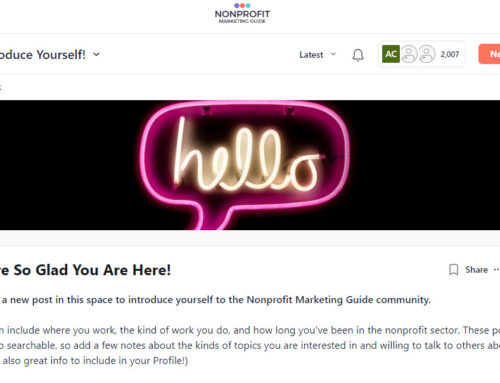 I can talk all day long about the benefits of and strategy behind content marketing (and some days I do!), but real world examples are also important. Seeing how an organization creates and implements a content marketing strategy can go a long way to helping you understand how content marketing can work for your cause. That’s why I was so happy to meet Joe Ventura, senior communications manager at Reading Partners, will be doing some posts for us on how they implemented a successful content marketing strategy. Today Joe starts us off with some background on how he went from nonprofit marketing skeptic to content marketing true believer. ~ Kivi
I can talk all day long about the benefits of and strategy behind content marketing (and some days I do!), but real world examples are also important. Seeing how an organization creates and implements a content marketing strategy can go a long way to helping you understand how content marketing can work for your cause. That’s why I was so happy to meet Joe Ventura, senior communications manager at Reading Partners, will be doing some posts for us on how they implemented a successful content marketing strategy. Today Joe starts us off with some background on how he went from nonprofit marketing skeptic to content marketing true believer. ~ Kivi
Guest Post by Joe Ventura of Reading Partners
After accepting my first communications position for an NGO, I remember telling my wife — mostly in jest — that the thing I would regret most by taking this job was no longer being able to laugh at the acerbic Texas comedian Bill Hick’s non-joke about marketers:
“By the way, if anyone here is in marketing or advertising…kill yourself. Thank you. Just planting seeds, planting seeds is all I’m doing.”
My goal throughout graduate school, where I studied International Relations and Intercultural Communications, had been to help nonprofit and non-governmental organizations communicate their work in a way that motivated people to help, to maximize the good they could do by clearly and engagingly communicating their work to prospective supporters. I resisted at first the tag “marketer” because I felt that it sullied the very real value that strategic communications could add to the work of organizations protecting the environment, improving education opportunities for women and children, and saving lives in conflict zones. Marketing, to me, meant manipulation for profit, and I wanted nothing to do with that.
Over the past decade, though, I’ve stopped worrying about being labeled a marketer and recently I’ve even actively started to embrace the moniker. Part of that has to do with recognizing that some marketing truly can change the world–by changing the actions people take to make our world safer, more just, and more beautiful. (In international development circles, they call that Behavior Change Communications–but it’s really just marketing.) At the same time as my own perceptions were changing, marketing itself was going through an evolution of sorts.
In the past decade, more traditional forms of marketing — magazine advertisements, TV spots, and online banner ads — became less and less effective at converting customers. Largely, this was due to emerging technologies which allowed those targeted by these forms of marketing to completely ignore them. DVRs, online ad blockers, and the rise of increasingly savvy web users meant marketers had to change or become obsolete.
The same technologies which subverted so many attempts at customer acquisition soon gave rise to a different philosophy in marketing: instead of trying to sell to “the general public,” let’s use the power of our digital tools to provide helpful, engaging, and entertaining content to that group of men and women most likely to be customers in the future. Rather than shout “Look at me!” to anyone and everyone within shouting distance, as traditional marketing does, content marketing is the art of creating or curating relevant and valuable content for the men and women most likely to be your supporters (or customers in the for-profit context). In this new model, marketers become more interested in providing timely, accurate, and clear information than in peddling subterfuge for profit’s sake.
Content marketing is especially suited for nonprofits with tight communications and fundraising budgets because resources can be focused on attracting men and women with a predisposition to support your cause. And while content marketing is not an easy strategy to implement, financially it’s much more efficient than traditional marketing.
When my wife sent me a link to Content Marketing for Nonprofits, I had been working on trying to apply a content marketing strategy in my role at Reading Partners, a national literacy nonprofit that recruits and trains volunteer tutors to work with struggling readers. There was little information out there on nonprofit marketers using content marketing techniques to attract volunteers and donors. Seeing Kivi’s book was a welcomed indication that nonprofit marketers were beginning to realize what a valuable and liberating tool this shift in perspective could be.
For the past year, I’ve been implementing a content marketing strategy at Reading Partners with the goal of recruiting more volunteer tutors and growing our individual donor base. Since beginning this experiment, we’ve seen powerful indicators that we’re on the right track: our social media following on Facebook, Twitter, and LinkedIn grew by more than 100%, while engagement on those platforms has been steadily growing as well. We’ve also witnessed a doubling of unique visitors to our website over the previous year, and our volunteer recruitment and repeat donors are higher than ever before.
I’ve been given the opportunity to talk about some of our experiences with content marketing in a series of guest blog posts here at Nonprofit Marketing Guide – stay tuned for another post on Tuesday!
Joe Ventura is the senior communications manager at Reading Partners, a national literacy program based in Oakland, CA. In the past year, Joe has led the organization in the adoption of a comprehensive content marketing strategy focused on increasing its volunteer and donor base. In the first year after adopting a content marketing strategy, Reading Partners increased its followers on Facebook and Twitter by over 100%, increased volunteer recruitment via our website by 15%, and increased the number of unique visitors to our website by over 50%.






